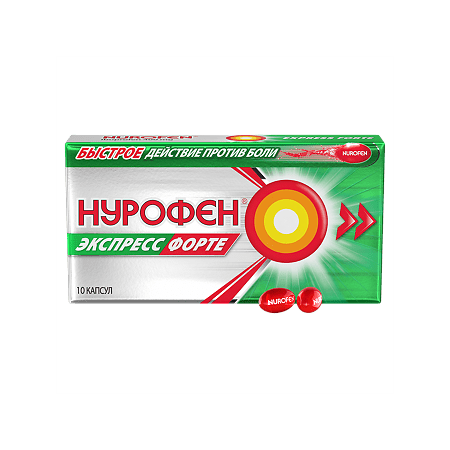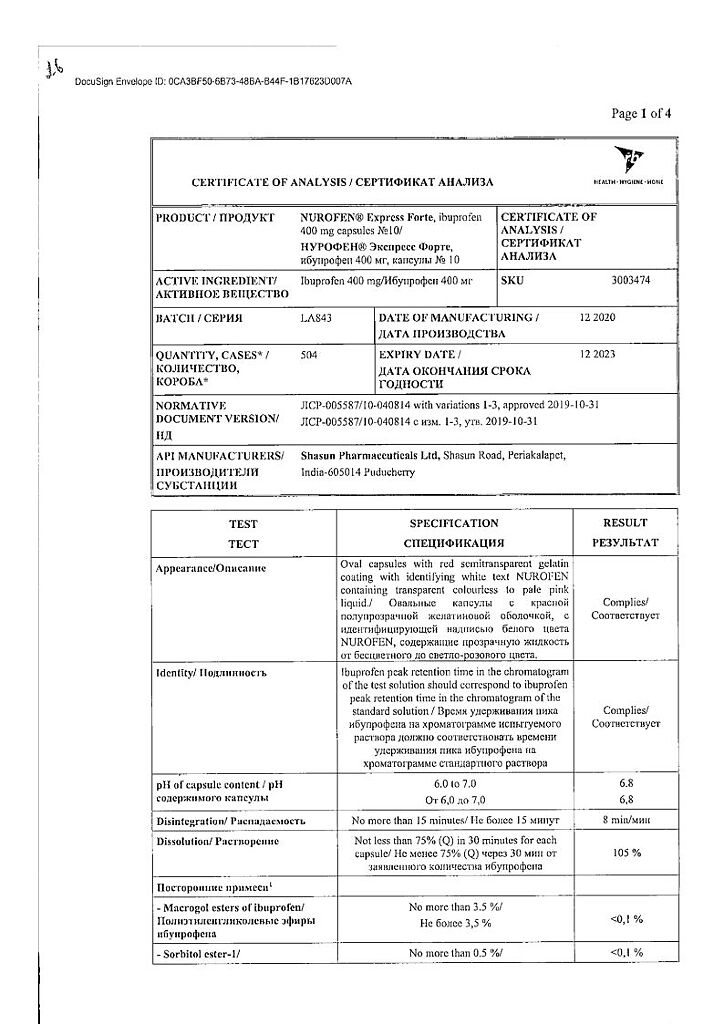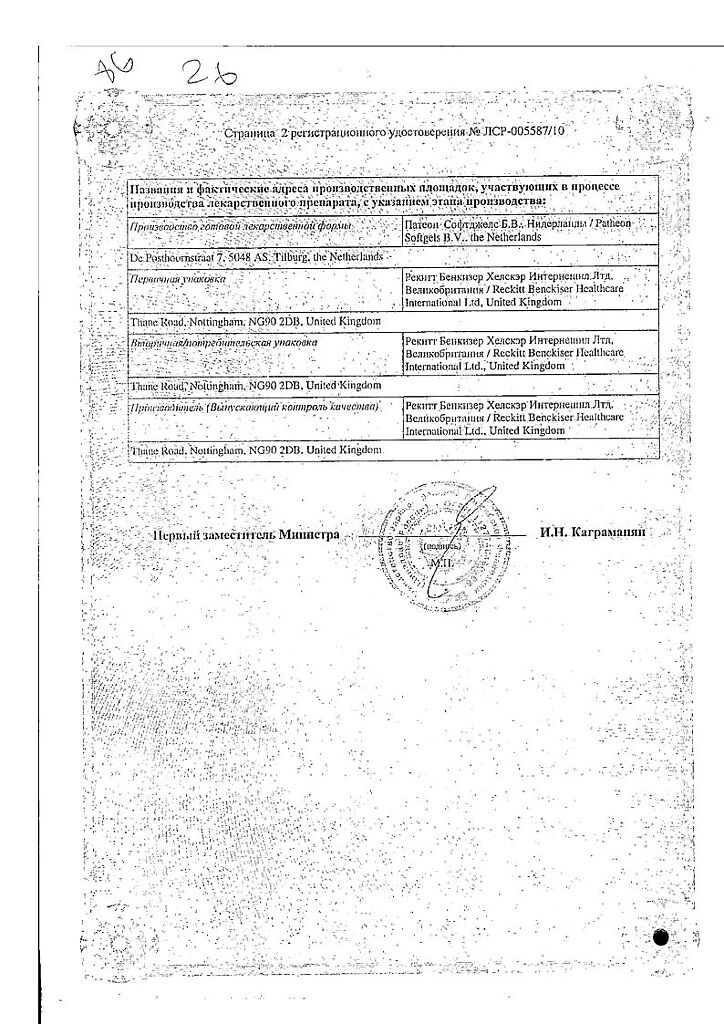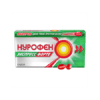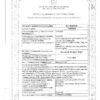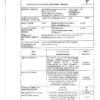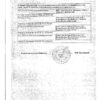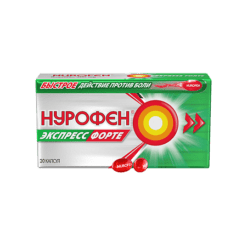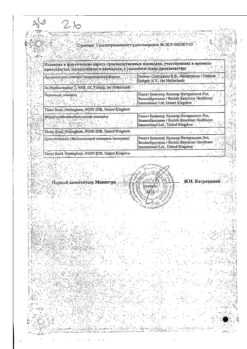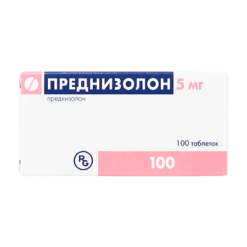No products in the cart.
Nurofen Express Forte, 400 mg capsules 10 pcs
€5.79 €5.15
Description
The double-concentrated liquid active ingredient capsule (400 mg ibuprofen)*** works directly at the source of pain to help relieve it.
The mechanism of action of ibuprofen, a propionic acid derivative of the nonsteroidal anti-inflammatory drugs (NSAIDs), is due to inhibiting the synthesis of prostaglandins, mediators of pain, inflammation and hyperthermia.
Inhibits cyclooxygenase-1 (COX-1) and cyclooxygenase-2 (COX-2) indiscriminately, thus inhibiting the synthesis of prostaglandins. It has a fast directed action against pain (analgesic), antipyretic and anti-inflammatory effect. In addition, ibuprofen reversibly inhibits platelet aggregation.
Pharmacokinetics
Absorption is high, quickly and almost completely absorbed from the gastrointestinal tract (GIT). After drug intake on an empty stomach, ibuprofen is detected in blood plasma within 15 minutes, maximum concentration (Cmax) of ibuprofen in plasma is reached after 30-40 minutes, which is twice as fast as after taking the equivalent dose of the drug Nurofen®, in dosage form of 200 mg coated tablets.
Ingestion of the drug with food may increase the time to reach maximum concentration (TCmax). The binding to plasma proteins is more than 90%, the half-life (T1/2) is 2 hours. Slowly penetrates into the joint cavity, stays in synovial fluid, creating higher concentrations in it than in blood plasma. After absorption, about 60% of the pharmacologically inactive R-form is slowly transformed into the active S-form. It is metabolized in the liver. It is excreted by kidneys (not more than 1% unchanged) and, to a lesser extent, with bile.
There were no significant differences in pharmacokinetic profile of the drug in elderly people compared to younger people.
In limited studies, ibuprofen was detected in very low concentrations in breast milk.
Indications
Indications
Nurofen® Express Forte is used for headaches, migraines, toothaches, painful menstruation, neuralgia, back pain, muscle and rheumatic pain; for feverish conditions, flu and colds.
Pharmacological effect
Pharmacological effect
A capsule with a liquid active ingredient in double concentration (400 mg ibuprofen)*** acts directly on the source of pain, helping to get rid of it.
The mechanism of action of ibuprofen, a derivative of propionic acid from the group of non-steroidal anti-inflammatory drugs (NSAIDs), is due to inhibition of the synthesis of prostaglandins – mediators of pain, inflammation and hyperthermic reaction.
Indiscriminately blocks cyclooxygenase-1 (COX-1) and cyclooxygenase-2 (COX-2), as a result of which it inhibits the synthesis of prostaglandins. It has a rapid, targeted effect against pain (analgesic), antipyretic and anti-inflammatory effects. In addition, ibuprofen reversibly inhibits platelet aggregation.
Pharmacokinetics
Absorption is high, quickly and almost completely absorbed from the gastrointestinal tract (GIT). After taking the drug on an empty stomach, ibuprofen is detected in the blood plasma after 15 minutes, the maximum concentration (Cmax) of ibuprofen in the blood plasma is achieved after 30-40 minutes, which is two times faster than after taking an equivalent dose of Nurofen®, in the dosage form of 200 mg film-coated tablets.
Taking the drug with food may increase the time to reach maximum concentration (TCmax). The connection with blood plasma proteins is more than 90%, the half-life (T1/2) is 2 hours. It slowly penetrates into the joint cavity, is retained in the synovial fluid, creating higher concentrations in it than in the blood plasma. After absorption, about 60% of the pharmacologically inactive R-form is slowly transformed into the active S-form. Metabolized in the liver. It is excreted by the kidneys (no more than 1% unchanged) and, to a lesser extent, with bile.
There were no significant differences in the pharmacokinetic profile of the drug in older adults compared to younger adults.
In limited studies, ibuprofen has been found in breast milk at very low concentrations.
Special instructions
Special instructions
It is recommended to take the drug for the shortest possible course and in the minimum effective dose necessary to eliminate symptoms. During long-term treatment, monitoring of the peripheral blood picture and the functional state of the liver and kidneys is necessary.
When symptoms of gastropathy appear, careful monitoring is indicated, including esophagogastroduodenoscopy, a complete blood count (hemoglobin determination), and a stool test for occult blood. If it is necessary to determine 17-ketosteroids, the drug should be discontinued 48 hours before the study. During the treatment period, ethanol intake is not recommended.
Patients with renal failure should consult a doctor before using the drug, as there is a risk of deterioration in the functional state of the kidneys.
Patients with arterial hypertension, including a history of and/or chronic heart failure, should consult a doctor before using the drug, since the drug may cause fluid retention, increased blood pressure and edema. Information for women planning pregnancy: the drug inhibits cyclooxygenase and prostaglandin synthesis and may affect ovulation, disrupting female reproductive function (reversible after discontinuation of treatment).
Impact on the ability to drive vehicles and machinery
Patients who experience dizziness, drowsiness, lethargy, or blurred vision while taking ibuprofen should avoid driving or operating machinery.
Active ingredient
Active ingredient
Ibuprofen
Composition
Composition
One capsule contains the active ingredient – ibuprofen 400 mg,
excipients:
Macrogol-600 335.3 mg,
potassium hydroxide 44.82 mg,
water 29.88 mg;
capsule shell:
gelatin 197 mg,
sorbitol (partially dehydrogenated) 95.68 mg,
water 25.02 mg,
crimson dye [Ponceau 4R] (E124) 0.79 mg,
white ink [Opacode WB NS-78-18011] (water 48%, titanium dioxide (E171) 29%, propylene glycol 10%, isopropanol 8%, hypromellose 3cP 5%).
Pregnancy
Pregnancy
The use of the drug is contraindicated in the third trimester of pregnancy. The use of ibuprofen should be avoided in the first and second trimesters of pregnancy; if it is necessary to take the drug, you should consult your doctor.
There is evidence that ibuprofen can pass into breast milk in small quantities without any adverse effects on the health of the nursing infant, so there is usually no need to stop breastfeeding when taken for a short period of time.
If long-term use of the drug is necessary, you should consult a doctor to decide whether to stop breastfeeding for the period of use of the drug.
Contraindications
Contraindications
Hypersensitivity to ibuprofen or any of the components included in the drug.
Complete or incomplete combination of bronchial asthma, recurrent nasal polyposis and paranasal sinuses, and intolerance to acetylsalicylic acid or other non-steroidal anti-inflammatory drugs (including a history).
Erosive and ulcerative diseases of the gastrointestinal tract (including gastric and duodenal ulcers, Crohn’s disease, ulcerative colitis) or ulcerative bleeding in the active phase or in history (two or more confirmed episodes of peptic ulcer or ulcerative bleeding).
A history of bleeding or perforation of a gastrointestinal ulcer caused by the use of NSAIDs.
Severe liver failure or active liver disease.
Severe renal failure (creatinine clearance <30 ml/min), confirmed hyperkalemia.
Decompensated heart failure; period after coronary artery bypass surgery.
Cerebrovascular or other bleeding.
Hemophilia and other bleeding disorders (including hypocoagulation), hemorrhagic diathesis.
Fructose intolerance.
Pregnancy (III trimester).
Children's age up to 12 years.
With caution
If you have the conditions listed in this section, you should consult a doctor before using the drug.
Concomitant use of other NSAIDs, a history of a single episode of gastric ulcer or gastrointestinal ulcer bleeding;
gastritis, enteritis, colitis, the presence of Helicobacter pylori infection, ulcerative colitis;
bronchial asthma or allergic diseases in the acute stage or in history – bronchospasm may develop;
systemic lupus erythematosus or mixed connective tissue disease (Sharpe’s syndrome) – increased risk of aseptic meningitis;
renal failure, including with dehydration (creatinine clearance 30-60 ml/min), nephrotic syndrome;
liver failure, liver cirrhosis with portal hypertension, hyperbilirubinemia, arterial hypertension and/or heart failure, cerebrovascular diseases;
blood diseases of unknown etiology (leukopenia and anemia), severe somatic diseases, dyslipidemia/hyperlipidemia, diabetes mellitus, peripheral arterial diseases;
smoking;
frequent drinking of alcohol;
simultaneous use of medications that may increase the risk of ulcers or bleeding, in particular oral glucocorticosteroids (including prednisolone), anticoagulants (including warfarin), antiplatelet agents (including acetylsalicylic acid, clopidogrel), selective serotonin reuptake inhibitors (including citalopram, fluoxetine, paroxetine, sertraline);
pregnancy I-II trimester, breastfeeding period, old age.
Side Effects
Side Effects
The risk of side effects can be minimized if the drug is taken in a short course at the minimum effective dose required to eliminate symptoms.
Side effects are predominantly dose-dependent. The following adverse reactions were observed with short-term use of ibuprofen in doses not exceeding 1200 mg/day (3 capsules). When treating chronic conditions and with long-term use, other adverse reactions may occur.
The frequency of adverse reactions was assessed based on the following criteria: very common (> 1/10), common (from > 1/100 to 1/1000 to 1/10,000 to < 1/1000), very rare (< 1/10,000), frequency unknown (no data available to estimate frequency).
Blood and lymphatic system disorders
Very rare: hematopoietic disorders (anemia, leukopenia, aplastic anemia, hemolytic anemia, thrombocytopenia, pancytopenia, agranulocytosis).
The first symptoms of such disorders are fever, sore throat, superficial oral ulcers, flu-like symptoms, severe weakness, nosebleeds and subcutaneous hemorrhages, bleeding and bruising of unknown etiology.
Immune system disorders
Uncommon: hypersensitivity reactions – nonspecific allergic reactions and anaphylactic reactions, reactions from the respiratory tract (bronchial asthma, including its exacerbation, bronchospasm, shortness of breath), skin reactions (itching, urticaria, purpura, Quincke’s edema, exfoliative and bullous dermatoses, including toxic epidermal necrolysis (Lyell’s syndrome), Stevens-Johnson, erythema multiforme), allergic rhinitis, eosinophilia.
Very rare: severe hypersensitivity reactions, including swelling of the face, tongue and larynx, shortness of breath, tachycardia, hypotension (anaphylaxis, Quincke’s edema or severe anaphylactic shock).
Gastrointestinal disorders
Uncommon: abdominal pain, nausea, dyspepsia (including heartburn, bloating).
Rarely: diarrhea, flatulence, constipation, vomiting.
Very rare: peptic ulcer, perforation or gastrointestinal bleeding, melena, hematemesis, in some cases fatal, especially in elderly patients, ulcerative stomatitis, gastritis.
Frequency unknown: exacerbation of colitis and Crohn’s disease.
Disorders of the liver and biliary tract
Very rare: liver dysfunction (especially with long-term use), hepatitis, jaundice.
Renal and urinary system disorders
Very rare: acute renal failure, hematuria and proteinuria, nephritic syndrome, nephrotic syndrome, papillary necrosis, interstitial nephritis, cystitis.
Nervous system disorders
Uncommon: headache.
Very rare: aseptic meningitis (isolated cases of symptoms of aseptic meningitis, such as a stiff neck, headache, nausea, vomiting, fever and disorientation, have been observed during treatment with ibuprofen in patients with autoimmune diseases (systemic lupus erythematosus and mixed connective tissue disease)).
Cardiovascular disorders
Frequency unknown: heart failure, peripheral edema, with long-term use there is an increased risk of thrombotic complications (for example, myocardial infarction or stroke), increased blood pressure.
Respiratory, thoracic and mediastinal disorders
Frequency unknown: bronchial asthma, bronchospasm, shortness of breath.
Laboratory indicators
hematocrit or hemoglobin (may decrease)
bleeding time (may increase)
plasma glucose concentration (may decrease)
creatinine clearance (may decrease)
plasma creatinine concentration (may increase)
activity of “liver” transaminases (may increase)
If side effects occur, you should stop taking the drug and consult a doctor.
Interaction
Interaction
The simultaneous use of ibuprofen with the following drugs should be avoided:
· Acetylsalicylic acid: with the exception of low doses of acetylsalicylic acid (no more than 75 mg per day) prescribed by a doctor, since combined use may increase the risk of side effects.
With simultaneous use, ibuprofen reduces the anti-inflammatory and antiplatelet effect of acetylsalicylic acid (an increase in the incidence of acute coronary insufficiency in patients receiving small doses of acetylsalicylic acid as an antiplatelet agent is possible after starting ibuprofen).
· Other NSAIDs, including selective cyclooxygenase-2 inhibitors: the simultaneous use of two or more drugs from the NSAID group should be avoided due to a possible increased risk of side effects.
Use with caution simultaneously with the following medications:
· Anticoagulants and thrombolytic drugs: NSAIDs may enhance the effect of anticoagulants, in particular warfarin and thrombolytic drugs.
· Antihypertensives (ACE inhibitors and angiotensin II antagonists) and diuretics: NSAIDs may reduce the effectiveness of drugs in these groups. Diuretics may increase the nephrotoxicity of NSAIDs.
· Glucocorticosteroids: increased risk of gastrointestinal ulceration and gastrointestinal bleeding.
· Antiplatelet agents and selective serotonin reuptake inhibitors: increased risk of gastrointestinal bleeding.
· Cardiac glycosides: simultaneous use of NSAIDs and cardiac glycosides can lead to worsening heart failure, a decrease in glomerular filtration rate and an increase in the concentration of cardiac glycosides in the blood plasma.
· Lithium preparations: there is evidence of the likelihood of an increase in the concentration of lithium in the blood plasma during the use of NSAIDs.
· Methotrexate: there is evidence of the likelihood of an increase in the concentration of methotrexate in the blood plasma during the use of NSAIDs.
Cyclosporine: increased risk of nephrotoxicity with concomitant use of NSAIDs and cyclosporine
· Mifepristone: NSAIDs should be started no earlier than 8-12 days after stopping mifepristone, as NSAIDs may reduce the effectiveness of mifepristone.
Tacrolimus: Concomitant use of NSAIDs and tacrolimus may increase the risk of nephrotoxicity.
· Zidovudine: Concomitant use of NSAIDs and zidovudine may result in increased hematotoxicity. There is evidence of an increased risk of hemarthrosis and hematomas in HIV-positive patients with hemophilia who received concomitant treatment with zidovudine and ibuprofen.
· Quinolone antibiotics: In patients receiving concomitant treatment with NSAIDs and quinolone antibiotics, the risk of seizures may be increased.
Overdose
Overdose
Use of the drug in children at a dose of 400 mg/kg may lead to symptoms of intoxication. In adults, the dose effect is less pronounced. The half-life of an overdose is 1.5-3 hours.
Symptoms.
Most patients who used clinically significant amounts of NSAIDs developed only nausea, vomiting, epigastric pain, or very rarely, diarrhea. Tinnitus, headache, and gastrointestinal bleeding may also occur.
With more severe poisoning, toxic damage to the central nervous system is possible, which manifests itself as vertigo, drowsiness, and sometimes agitation and disorientation or coma.
Sometimes patients experience seizures. In severe poisoning, hyperkalemia and metabolic acidosis may develop, and an increase in prothrombin time/increase in the prothrombin index may occur, possibly as a result of effects on circulating coagulation factors. Acute renal failure, liver damage, arterial hypotension, respiratory failure and cyanosis may develop.
In patients with bronchial asthma, an exacerbation of the disease may occur.
Treatment.
Treatment should be symptomatic and supportive and include maintaining the airway and monitoring cardiac and vital signs until the condition returns to normal.
It is recommended to administer activated charcoal orally or gastric lavage within 1:00 after taking a potentially toxic dose of the drug. If ibuprofen has already been absorbed into the body, alkaline substances can be administered to speed up the excretion of acidic ibuprofen in the urine.
For frequent or prolonged seizures, diazepam or lorazepam should be used intravenously. To treat exacerbation of bronchial asthma, bronchodilators should be used.
Storage conditions
Storage conditions
In a dry place at a temperature not exceeding 25 °C.
Shelf life
Shelf life
3 years. Do not use after the date indicated on the package.
Manufacturer
Manufacturer
Patheon Softgels B.V., The Netherlands
Additional information
| Shelf life | 3 years. Do not use after the date on the package. |
|---|---|
| Conditions of storage | In a dry place at a temperature not exceeding 25 ° C. |
| Manufacturer | Reckitt Benckiser Healthcare International Ltd, United Kingdom |
| Medication form | capsules |
| Brand | Reckitt Benckiser Healthcare International Ltd |
Other forms…
Related products
Buy Nurofen Express Forte, 400 mg capsules 10 pcs with delivery to USA, UK, Europe and over 120 other countries.

